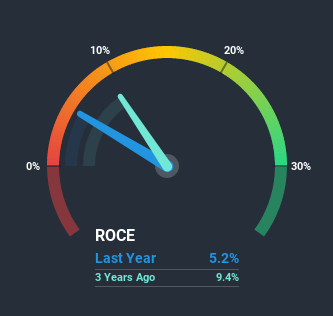
What underlying fundamental trends can indicate that a company might be in decline? When we see a declining return on capital employed (ROCE) in conjunction with a declining base of capital employed, that's often how a mature business shows signs of aging. This combination can tell you that not only is the company investing less, it's earning less on what it does invest. So after we looked into KITA KOUDENSHA (SPSE:1734), the trends above didn't look too great.
Return On Capital Employed (ROCE): What is it?
For those who don't know, ROCE is a measure of a company's yearly pre-tax profit (its return), relative to the capital employed in the business. The formula for this calculation on KITA KOUDENSHA is:
Return on Capital Employed = Earnings Before Interest and Tax (EBIT) ÷ (Total Assets - Current Liabilities)
0.052 = JP¥366m ÷ (JP¥9.3b - JP¥2.2b) (Based on the trailing twelve months to December 2020).
Therefore, KITA KOUDENSHA has an ROCE of 5.2%. Ultimately, that's a low return and it under-performs the Construction industry average of 10%.
View our latest analysis for KITA KOUDENSHA

Historical performance is a great place to start when researching a stock so above you can see the gauge for KITA KOUDENSHA's ROCE against it's prior returns. If you want to delve into the historical earnings, revenue and cash flow of KITA KOUDENSHA, check out these free graphs here.
So How Is KITA KOUDENSHA's ROCE Trending?
In terms of KITA KOUDENSHA's historical ROCE movements, the trend doesn't inspire confidence. Unfortunately the returns on capital have diminished from the 18% that they were earning five years ago. On top of that, it's worth noting that the amount of capital employed within the business has remained relatively steady. This combination can be indicative of a mature business that still has areas to deploy capital, but the returns received aren't as high due potentially to new competition or smaller margins. So because these trends aren't typically conducive to creating a multi-bagger, we wouldn't hold our breath on KITA KOUDENSHA becoming one if things continue as they have.
On a side note, KITA KOUDENSHA has done well to pay down its current liabilities to 24% of total assets. That could partly explain why the ROCE has dropped. Effectively this means their suppliers or short-term creditors are funding less of the business, which reduces some elements of risk. Since the business is basically funding more of its operations with it's own money, you could argue this has made the business less efficient at generating ROCE.
Our Take On KITA KOUDENSHA's ROCE
In the end, the trend of lower returns on the same amount of capital isn't typically an indication that we're looking at a growth stock. In spite of that, the stock has delivered a 24% return to shareholders who held over the last five years. Either way, we aren't huge fans of the current trends and so with that we think you might find better investments elsewhere.
If you want to know some of the risks facing KITA KOUDENSHA we've found 2 warning signs (1 is significant!) that you should be aware of before investing here.
While KITA KOUDENSHA isn't earning the highest return, check out this free list of companies that are earning high returns on equity with solid balance sheets.
When trading KITA KOUDENSHA or any other investment, use the platform considered by many to be the Professional's Gateway to the Worlds Market, Interactive Brokers. You get the lowest-cost* trading on stocks, options, futures, forex, bonds and funds worldwide from a single integrated account. Promoted
Valuation is complex, but we're here to simplify it.
Discover if KITA KOUDENSHA might be undervalued or overvalued with our detailed analysis, featuring fair value estimates, potential risks, dividends, insider trades, and its financial condition.
Access Free AnalysisThis article by Simply Wall St is general in nature. It does not constitute a recommendation to buy or sell any stock, and does not take account of your objectives, or your financial situation. We aim to bring you long-term focused analysis driven by fundamental data. Note that our analysis may not factor in the latest price-sensitive company announcements or qualitative material. Simply Wall St has no position in any stocks mentioned.
*Interactive Brokers Rated Lowest Cost Broker by StockBrokers.com Annual Online Review 2020
Have feedback on this article? Concerned about the content? Get in touch with us directly. Alternatively, email editorial-team (at) simplywallst.com.
About SPSE:1734
KITA KOUDENSHA
KITA KOUDENSHA Corporation engages in indoor wiring work, power related construction, FA housing environment equipment, and industrial equipment businesses in Japan.
Slightly overvalued with weak fundamentals.
Market Insights
Community Narratives



